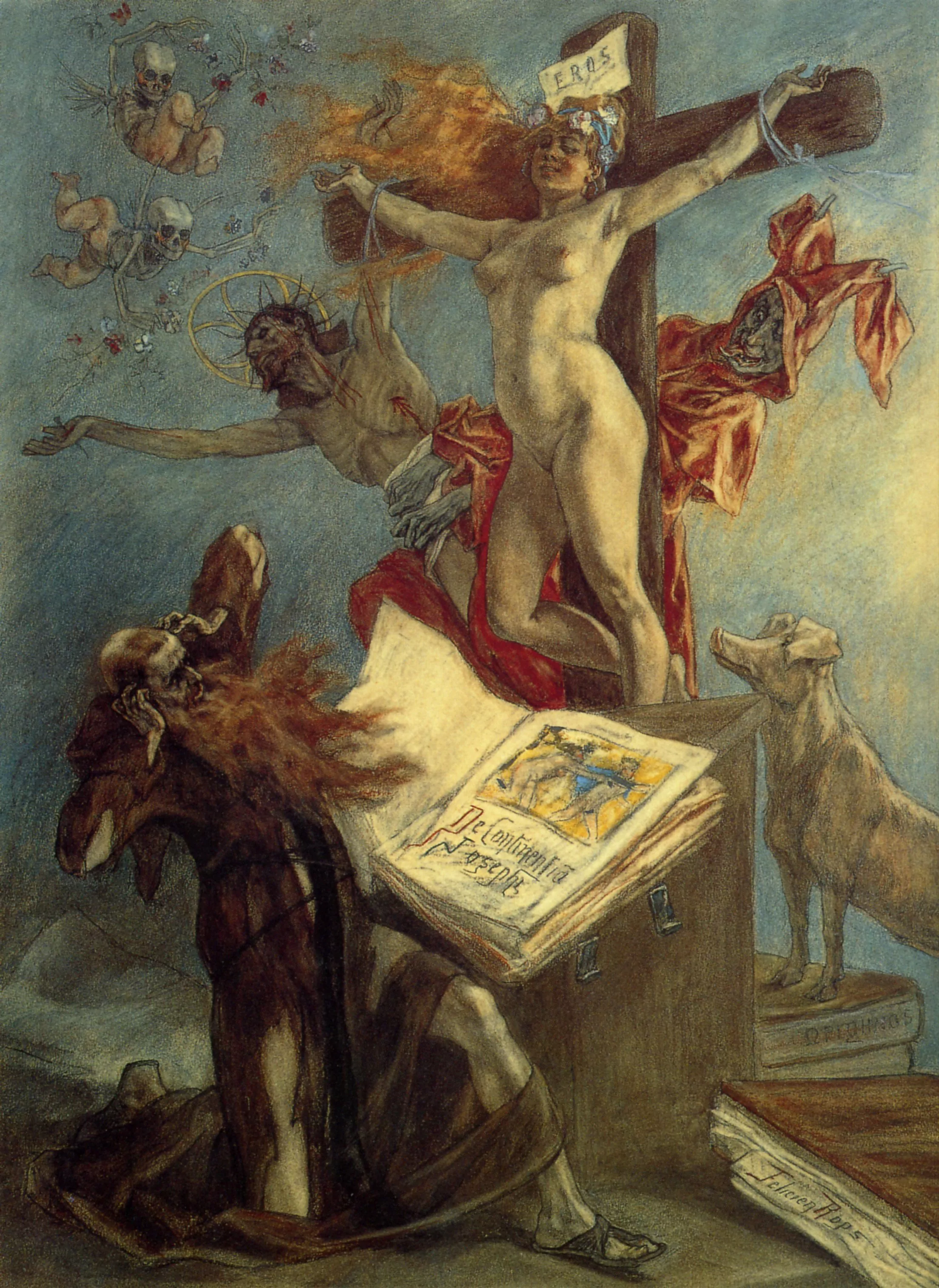Félicien Rops
Blasphemy is the ultimate kink




He’s been called a provocateur, a pornographer, and a blasphemer, but Félicien Rops defined himself with sneering clarity: “Rops am I, virtuous am I not, hypocrite I do not deign.” I love this quote, because it cuts through the temptation to over-intellectualize his artwork. Horny art is always personal. And good lord is Rops’ work horny. Not content to depict languorous nudes in the academically approved genres of orientalist ‘other’ or mythological beauty, Rops jumped straight to the gnarly, grotesque, demonic and profane. It is unquestionably designed to irritate and offend, but Rops was clear on one thing—to him, this stuff was hot as hell.
Rops was the only son of a wealthy textile manufacturing family, educated by private tutors and in exclusive Jesuit academies in Belgium. He was smart, able to recite long passages of scripture in Latin, but more interested in making “uninhibited” cartoons of his teachers. At 18, Rops moved to Brussels to study law, but two years later abandoned the major to study art, drawing and printmaking at the Académie de Saint-Luc, where his bohemian tenancies landed him in a crew of social realist sculptors, printmakers and artsy weirdos.
At 24, Rops speed ran “normal life” marrying Charlotte Polet de Faveaux, and posing as a country gentleman at her ancestral castle of Thozée. But recreational painting, botany, rowing and parenting his son Paul and daughter Juliet (who died at age five) grew tiresome, and Rops took longer and longer trips to Brussels, Namur and Paris.
Paris was a gravity well for intellectuals and artists and decadents, and it was there Rops met the poet and king-pervert Baudelaire. The two connected with an intensity unique to intellectual weirdos. Rops loved Baudelaire’s facility with language, saying “I never once saw him consult a dictionary. He didn't have any, and didn't want to have any...saying ‘A man who looks up a word in a dictionary is like a conscript who, upon receiving the order to fire, looks for a cartridge in his pouch.'” And Baudelaire at last found a kindred alien, writing to Monet “Rops is the only true artist (in the sense in which I, and perhaps I alone, understand the word artist), that I have found in Belgium.”
Together, Rops and Baudelaire adopted the self-described lifestyle of “the decadent” embracing pleasure, passion, fantasy and exotic indulgence as a ‘fuck you’ to society’s obsession with order and progress. In art, this meant exploring depravity, horror, and weird, nasty sex. While his artistic production ranged across portraiture, caricature, and editorial illustration, Rops eventually landed on a yin yang of subject matter perfectly calibrated to shock the plebs. Les Diaboliques, Rops most famous series, featured Satan and his randy demons eternally cavorting with the archetypal fallen woman, debasing herself in pursuit of erotic pleasure.
More than a philosophy, decadence became Rops life. His visits to Paris became extended stays, and in the early 1870s his philandering finally broke his wife Charlotte. She wrote him a letter. “Your latest despicable affair, the eighth since I met you and we were married, was your way of punishing others, you killed me! Since you don't want to see me any more and asked me not to write to you any more, I want my last word to you to be a word of pardon.” Cut loose from traditional married life, Rops revealed his latest flagrant affair, a ménage à trois with two young sisters Aurélie and Léontine Duluc. The trio used Paris as a home base while traveling to the United States and Canada, and Rops leveraged his status as “the best paid illustrator in France” to travel to Sweden, Norway, Hungary, Spain and Northern Africa.
Degenerate as Rops liked to appear, his later life settled into more pastoral patterns. His polyamorous relationship with the Duluc sisters was long-running, lasting twenty-five years until his death in 1898, and the artist settled into a mentorship role in Les Vingt, a progressive art collective that included James Ensor, Théo van Rysselberghe, and Fernand Khnopff, and a contributing membership to the Freemasons.
Back to the art. It’s tempting to consider our modern age as the pinnacle of extreme content, but Rops’ imagination is still capable of raising an eyebrow. Below I’ve collected examples of Les Diaboliques, his seminal series of depraved, humorous, and wide-ranging exploration of desire, perversion, and demonic canoodling. Even in 2022, this is some wild stuff. The giant phalluses are just the beginning. There is bondage, erotic asphyxiation, coprophilia, and an impressive variety of blasphemous sexual acts that would have even the most hardened internet deviant nodding in recognition.
I don’t really know how to end this biography. Rops was a weirdo and a proud deviant, but in his day he was also a counterculture hero, beloved by many of the artists we lionize today. He pushed the envelope in every way he knew how, yet today, Rops isn’t very well-known, though if I had a guess I suspect that’s more due to the historical bias towards painters over printmakers than to his iconoclastic work and life. I don’t know. Take it or leave it, I’m certain that Rops didn’t care what the future would think of him.
...
Got questions, comments or corrections about Félicien Rops? Join the conversation in our Discord, and if you enjoy content like this, consider becoming a member for exclusive essays, downloadables, and discounts in the Obelisk Store.